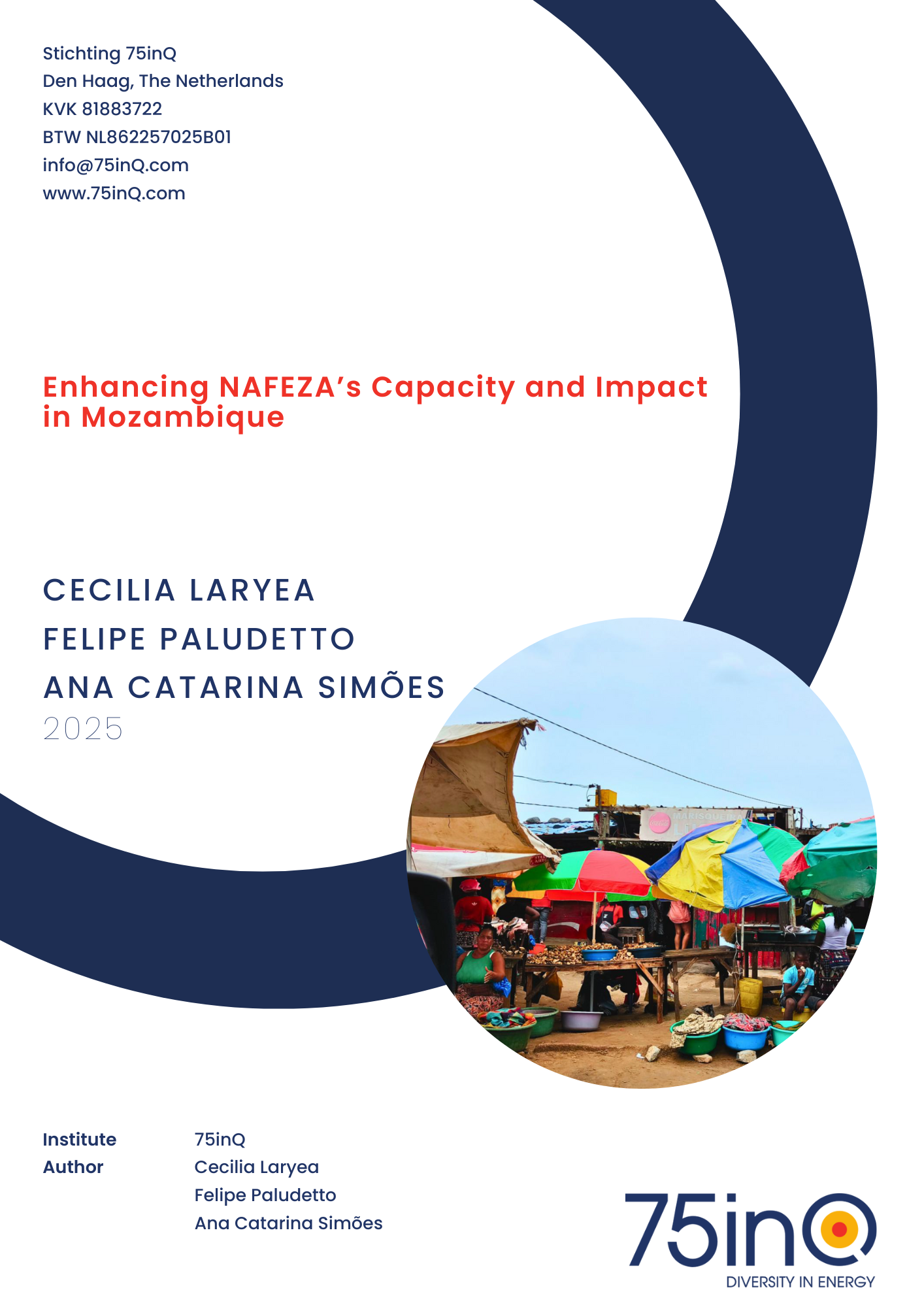Enhancing NAFEZA’s Capacity and Impact in Mozambique
report
Authors: Cecilia Laryea, Felipe Paludetto, Ana Catarina Simões
June 2025
Citation
Enhancing NAFEZA’s Capacity and Impact in Mozambique, 75inQ, 2025

Briefing Paper
| Date | June 2025 |
| Authors | Cecilia Laryea, Felipe Paludetto, Ana Catarina Simões |
Executive Summary
This briefing paper reflects on the insights obtained during a capacity-building initiative undertaken with Núcleo das Associações Femininas da Zambézia (NAFEZA), a women-led coalition in Zambézia Province, Mozambique. The project focused on three methodological axes: participatory fundraising training, development of tailored monitoring and evaluation (M&E) systems, and the launch of communication strategies to improve public visibility. A hybrid approach, which combined in-person workshops, continued remote mentoring, and accessible digital tools, enabled foundational changes, despite a few challenges.
Key lessons learned suggest that organisational transformation requires behavioural change, internal ownership, and a sensitivity to the organisational context. Although short-term support generated clear outputs (e.g., four grant proposals, a co-designed M&E system, over 2,500 social media views), deeper institutional shifts, such as governance reform, a proactive fundraising culture, and consistent documentation, require a long-term engagement with the institution. Communication, which was often seen as secondary, proved central to building credibility and organisational legitimacy.
Introduction
This briefing paper presents key insights, challenges, and reflections from a capacity-building initiative led by 75inQ in collaboration with NAFEZA. It aimed to strengthen core areas of institutional capacity, including fundraising, M&E, and strategic communications, using a context-sensitive approach. What follows is an overview of the methods used, key activities implemented, and the lessons learned for both grassroots organisations and their supporting partners.
1. Context-responsive support as a pillar of institutional strengthening
In March 2025, a team from 75inQ, a women-led NGO in the Netherlands, embarked on a field visit to Quelimane (headquarters of NAFEZA) to engage in an immersive collaboration with NAFEZA staff. The team employed a methodology that prioritised participatory learning and respect for local pace and structure, while integrating on-site training with remote mentoring. This hybrid approach was essential in navigating language barriers, informal workflows, political instability and digital limitations.
Eight structured workshops were held:
- 3 sessions on Monitoring & Evaluation (M&E)
- 2 sessions on fundraising and proposal development
- 1 session on digital tools and documentation
- 1 session on the theory of change
- 1 session on SWOT analysis
The sessions employed real-case exercises, planning-by-objectives, and SWOT analysis. However, time constraints and language barriers, especially the need for full-session translation from English to Portuguese, limited spontaneity and sometimes diluted group energy and peer learning.
2. Fundraising as a shared organisational function
“Who wants to be a fundraiser?” Workshop
The “Who Wants to Be a Fundraiser?” workshop served to position resource mobilisation as an institutional responsibility. The workshop began with a provocative question: “If all the funds that NAFEZA receives ended today, what would happen?” to raise awareness about the importance of diversifying funding sources. Further questions were raised to challenge assumptions around sustainability, and the staff was introduced to hands-on donor mapping and compliance tools to initiate a culture of systematic fundraising.
A proposal training class was executed to strengthen the identification and pursuit of tenders and proposals. Four proposals were submitted, with two pre-selected. A donor pipeline and compliance matrix were introduced, but ongoing bottlenecks such as language gaps, financial informality, time constraints and proposal ownership proved to slow down the proposal process.
3. M&E Development as a propellant of internal culture change
Co-design and framework implementation
A comprehensive Monitoring & Evaluation framework was co-designed and piloted with 11 staff who were trained in data collection, documentation, and reporting using Excel, Canva, and the Microsoft Office suite. Standardised KPIs and templates were introduced to improve consistency across programmes. The culture of routine tracking and self-evaluation was fragile. Some teams adopted the system eagerly while others defaulted to ad hoc habits without external prompting.
4. Visibility and communication
Communication strategy implementation
Communication was reframed to achieve legitimacy and outreach. A structured plan led to the launch of social media platforms (Instagram, Facebook, LinkedIn), infographics, staff stories, and a website (pending registration).
Initial results were promising: 2,500 total views, 1,612 unique account reaches, and a 5.4% engagement rate. The peaks aligned with key moments, such as International Women’s Day, to encourage timely advocacy.
Key insights:
- To ensure a more lasting impact, support mechanisms must be designed to adapt to informal governance structures, language barriers, and uneven levels of digital fluency.
- Participatory methods will only lead to lasting change when backed by ongoing reinforcement and internal champions. Strategies must be put in place to ensure that efforts are not lost once external pressures are gone.
- Fundraising capacity is an internal structure that is characterized by shared accountability and professionalized financial systems. Where these are weak, even motivated teams will struggle to translate strategy into funding.
- M&E must be seen not just as an obligation to funders and the organisation, but also as a tool to prove the will and determination of the organisation. Capacity-building succeeds when data becomes useful to both the organisation and external funders.
- Digital visibility must be owned, not outsourced. Without internal champions and scheduled content routines, even well-designed strategies risk dormancy.
5. Challenges and adaptations
Identified limitations:
- Digital infrastructure gaps: Internet instability and limited access to devices and modern software impeded virtual training and remote follow-up.
- Staffing and skills gaps: A shortage of staff with strong English-language skills created bottlenecks in workshop participation, documentation, and proposal writing. All training had to be executed through a translator when the training coordinator was English-speaking.
- Organisational culture: Entrenched habits made it difficult to integrate some new governance and documentation practices within the short project timeline.
- Limited timeframe: The three-month engagement period was insufficient to embed deeper reforms in financial governance or long-term strategic planning.
- Political instability: The political atmosphere was uncertain, and logistics became unpredictable, especially for trainers flying to Mozambique from their home countries.
- Funding: Restricted resources meant key activities (e.g., website domain, volunteer travel) were deferred.
6. Lessons for institutional support practice
Effective principles:
- Progress takes time: Organisational strengthening is a long-term process. Short-term interventions can cause change, but they need follow-up and reinforcement.
- Documentation is empowerment: Teams became more confident when they could track, interpret, and communicate their work.
- Visibility requires ownership: Social media strategies work best when fully integrated into the team’s daily routine. Without internal buy-in, digital channels can go dormant.
Fundraising-specific lessons:
- Systematic information management is critical: The lack of structured fundraising databases significantly hampers organisational learning and credibility building with donors.
- Financial professionalization enables growth: Informal financial practices limit access to institutional funding sources that require established governance standards.
- Donor relationship cultivation is more efficient than constant prospecting: Investing in maintaining relationships with previous supporters represents a more sustainable strategy
7. Recommendations
For grassroots NGOs:
- Assign internal leads for fundraising and communication with clear responsibilities.
- Institutionalize M&E with periodic review cycles.
- Create social media calendars and storytelling routines.
For funders and partners:
- Extend timelines for structural support initiatives.
- Provide unrestricted funding for digital tools and documentation systems.
- Prioritise embedded accompaniment models over one-off training.
- Fund organisations that have a standing SWOT analysis and theory of change documentation
Conclusion
NAFEZA’s journey demonstrates that in institutional strengthening, real organisational transformation is possible, but fragile. Short-term results like frameworks, platforms, and proposals greatly matter. But they only last if the internal ecosystem evolves with them. This case reinforces a central truth for practitioners: institutional support is about capacity, ownership, time and funding.
Bibliography
Eade, D. (2007). Capacity building: An approach to people-centred development. Oxfam GB. https://policy-practice.oxfam.org/resources/capacity-building-an-approach-to-people-centred-development-122906/
Freire, P. (1970). Pedagogy of the oppressed. Continuum International Publishing Group. https://envs.ucsc.edu/internships/internship-readings/freire-pedagogy-of-the-oppressed.pdf
Klein, K. (2016). Fundraising for social change (7th ed.). Jossey-Bass. https://www.haasjr.org/sites/default/files/perspectives/Haas_BrightSpots_F2.pdf
Sargeant, A., & Jay, E. (2014). Fundraising management: Analysis, planning and practice (3rd ed.). Routledge. https://www.routledge.com/Fundraising-Management-Analysis-Planning-and-Practice/Sargeant-Jay/p/book/9780415534239
Warwick, M. (2013). How to write successful fundraising appeals (3rd ed.). Jossey-Bass. https://archive.org/details/isbn_9780787999087/page/n1/mode/2up



